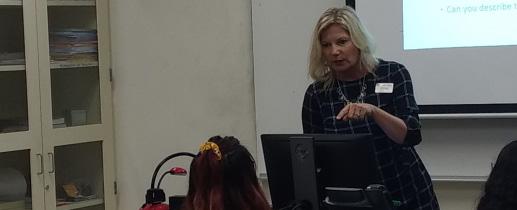
4 minute read
Directing Science
Linda Lamp speaking to an intern. Photo by Brody Salazar.
Brody Salazar @Brody_Salazar
Advertisement
4 F rom 3D printers to summer internships, Chaffey College Science, Technology, Engineering and Mathematics (STEM) Grant Director Linda Lamp has brought waves of change in her 12 months leading the department. Although she has spent a year leading the department, eight of those months were being spent as an interim director before she applied for the permanent position.
As grant director, Lamp used a budget of $3.875 million to establish a “Makerspace,” expand the “living lab” curriculum, incorporate predictive analytics and organize the summer STEM internship. According to Chaffey College Dean of Math and Science Theodore Younglove, Lamp often does not “give herself the credit she deserves” despite being a large part of the program. He goes on to describe her as being “critical” to the process of realizing how to accomplish their goals.
“Her contribution is huge,” Younglove states. “She’s making a gigantic difference on the grant, and in math and science. She prefers to work in the background and not say anything, but I think she deserves some credit.”
Lamp has been a part of the science department for 13 years, and in that time she has built up many connections at Chaffey. Although she did not know it, these connections would later come to serve her when she became the STEM grant director. Lamp cites the bonds she formed as some of the many reasons for her accomplishments in her new position. One such accomplishment includes establishing the Makerspace, which contains 3D printers, robotics, virtual reality and various “kits” to be used for testing different projects. Although the Makerspace provides many services for Chaffey students, it was difficult to find an area that was capable of supporting it.
In addition, there was difficulty with staffing the Makerspace, as there would not be enough money in the budget. However, Lamp discovered there was an empty space in Chaffey’s Rancho campus Math Success Center and used the area for the Makerspace.
“We had an instruction specialist that was running the Math Success Center,” Lamp explains. “And when we were looking for a space for the Makerspace, he said, ‘Why don’t you put it inside in one of our rooms in there? Because hopefully it will draw students into the Makerspace, and they’ll have to walk through the Math Success Center.’”
Another achievement of Lamp’s includes expanding Chaffey’s living lab curriculum. Living lab refers to science activities that involve participation, such as the Burrowing Owls Festival hosted by Chaffey College’s Chino campus. These types of activities often prove useful to more kinesthetic learners, as it provides a hands-on experience that you otherwise would not receive.
According to Lamp, the experience has even been enough to change the course of some students’ paths. She claims one student decided to dedicate themselves to wildlife conservation because of their brief time with the burrowing owls.
“There’s data that shows,” says Lamp, “if you’re in a classroom, and you have a professor, they’re lecturing... To support that learning, if you take the students outside and actually show them what they’re teaching you in real life, it really supports that learning.”
Encouragement to living lab curriculum extends beyond the activities themselves. There is an annual “Living Lab Symposium,” which Lamp describes as a place for the professor and faculty to share the different activities they have held, and how it has helped the students.
Although Younglove had more of a hand in its creation, Lamp also shares some credit for the incorporation of predictive analytics with the Math and Science department. Lamp describes it as an assessment created by a research analyst working with faculty to create a way to determine which students might need more help. Lamp claims this will help students earn their degree or transfer.
“The sooner you get to students who are struggling, the better their chances at success are,” says Lamp.
Lastly, the STEM internship required the most work, as it involved coordinating with different locations to allow Chaffey students to conduct their research. Lamp emphasizes how important the team working beneath her was in this process. According to Younglove, each essential member of the team was picked by Lamp.
Each site had different needs to be met, and some were more difficult to meet them than others. The most common difficulty faced was getting all of the locations to agree despite host liability.
In addition to coordinating with the locations, Lamp also handles the distribution of funds in ways other intern programs might overlook. Lamp, recognizing that many Chaffey students need to support themselves, did not want to leave the students with only the experience of research. As a result, she ensured that intern involved with the program would be paid minimum wage.
To determine who was accepted into the internship, Lamp and her team created a scoring rubric loosely based off of one Mt. San Antonio College uses for their program. After being selected, students would be ranked and choose their top three locations they would like to visit.
Lamp emphasized the impact the internship has had on some students, citing how some interns have changed the course of their education based on their experiences.
One student, Samantha Negrete, got a paper published and was invited to speak at the 87th Annual Conference of Mosquito and Vector Control in San Francisco after her internship at the Orange County Mosquito and Vector Control District last year.
One of the reasons Lamp applied for the permanent position was because she wanted to make sure she could continue seeing the programs she worked on grow and positively affect students.










